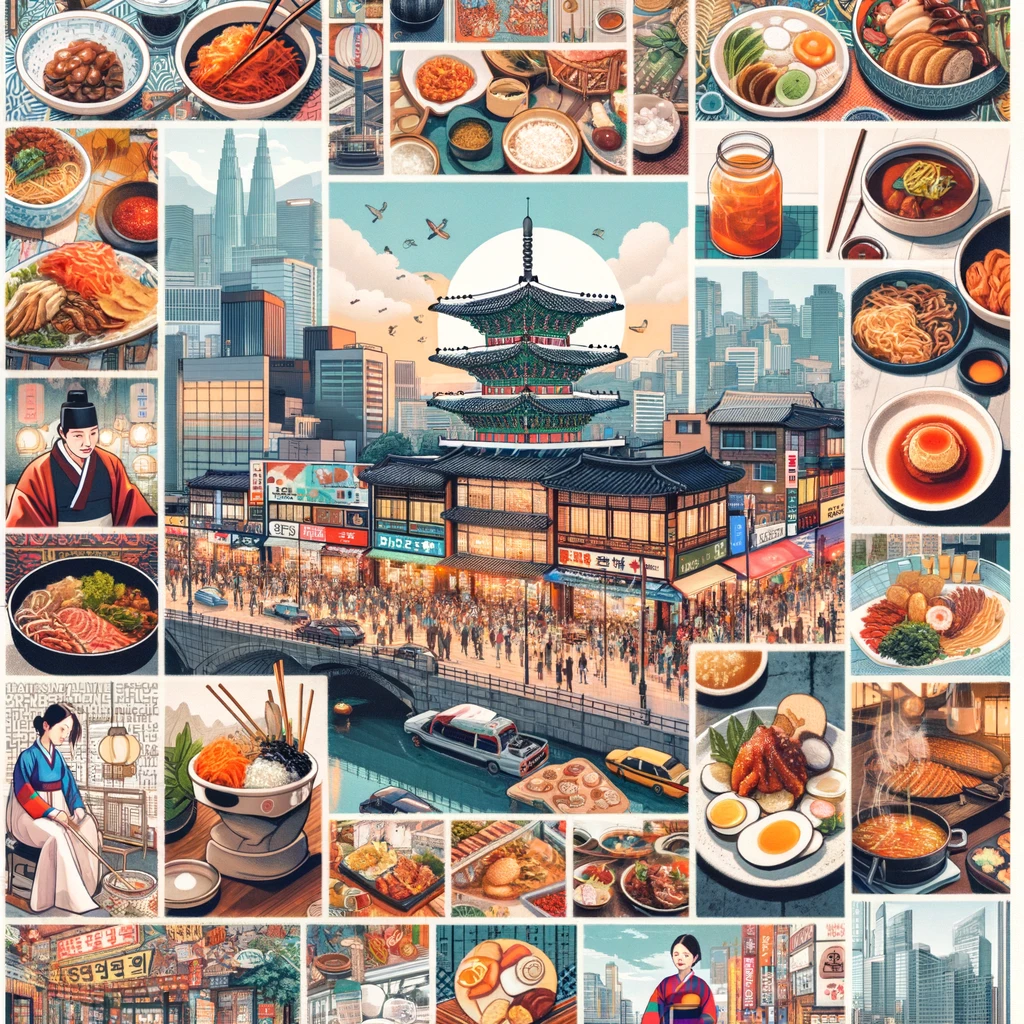Top Things to Eat in Seoul: Kimchi to Bingsu

1. Kimchi
Kimchi is a traditional Korean side dish that involves fermenting vegetables like cabbage with garlic, chili paste, and green onions. This process not only enhances the flavor of foods but also boosts the food’s nutritional value by creating probiotics and preserving vitamins.
This iconic dish adds a unique tangy and spicy kick to meals, making it a staple in Korean cuisine enjoyed by food lovers worldwide. The combination of flavors from gochujang and other seasonings creates a complex taste profile that pairs well with white rice or as an accompaniment to various dishes.
Kimchi is not just about taste; it also offers health benefits due to its fermentation process. The presence of beneficial bacteria supports gut health, while ingredients like garlic are known for their immune-boosting properties.
For those looking to explore authentic Korean flavors and cuisine, kimchi is a must-try that showcases the essence of Korean culinary traditions through its bold and vibrant flavors.
2. Bibimbap
Bibimbap, a beloved Korean rice dish, features a vibrant mix of vegetables, meat, and a crispy fried egg on top. This iconic meal is traditionally served in a sizzling hot stone bowl.
The key to bibimbap’s deliciousness lies in the gochujang sauce – a spicy and tangy condiment that elevates the flavors of the dish. It adds depth and heat to this already flavorful ensemble.
Not only is bibimbap visually appealing with its array of colors from assorted veggies like carrots, spinach, and mushrooms; it also provides a wholesome and balanced meal option rich in essential nutrients.
Whether enjoyed at an upscale restaurant or from street food vendors in Seoul‘s bustling markets, bibimbap offers diners a taste of Korea’s culinary heritage in every bite. Its versatility makes it suitable for any time of day – be it lunch or dinner – providing both comfort and satisfaction with each serving.
3. Samgyeopsal
Samgyeopsal is a beloved Korean barbecue dish that features succulent grilled pork belly slices, offering a delightful blend of flavors and textures.
Typically, this barbecue dish is savored by wrapping the meat in lettuce leaves along with accompaniments like spicy ssamjang sauce, garlic, and various pickled vegetables.
The interactive nature of samgyeopsal dining enhances the overall experience as diners engage in grilling their own meat at the table, fostering a social and engaging atmosphere.
Pairing well with soju or makgeolli (traditional rice wine), samgyeopsal not only satisfies taste buds but also provides an immersive cultural experience for those seeking to delve into Korean cuisine.
4. Tteokbokki
Tteokbokki is a popular Korean street food made of spicy stir-fried rice cakes drenched in a flavorful gochujang-based sauce. Often served with fish cakes, vegetables, and boiled eggs, this food offers a delightful mix of textures and flavors that captivate the taste buds.
The chewy texture of the rice cakes combined with the bold spiciness of the gochujang sauce creates a harmonious balance that keeps people coming back for more. This snack has become an iconic representation of Korean food and culture due to its widespread popularity across Korea.
Tteokbokki’s affordability and accessibility make it a favorite among locals and tourists alike, offering a quick yet satisfying culinary experience on bustling streets or in cozy eateries throughout Seoul. The dish’s versatility allows for variations like adding cheese or seafood to cater to different preferences while maintaining its signature essence.
With its rich history dating back centuries as a humble comfort food enjoyed by all generations, tteokbokki continues to evolve with modern twists without losing its traditional charm. Whether you’re seeking an authentic taste of Korea or simply craving something savory and spicy, tteokbokki stands out as a must-try delicacy when exploring Seoul’s vibrant food scene.
5. Japchae
Stir-fried glass noodles, japchae is a beloved Korean dish made from sweet potato starch. These translucent noodles are combined with an array of colorful vegetables, tender meat slices, and seasoned with soy sauce for a delightful umami flavor.
Japchae stands out for its unique chewy texture derived from the sweet potato starch used in making the noodles. This chewiness adds an interesting contrast to the medley of crunchy vegetables and succulent meat pieces within the dish.
The savory taste of japchae comes from the harmonious blend of ingredients during stir-frying. The soy sauce not only enhances the overall flavor profile but also gives the dish its signature rich and slightly sweet undertones that appeal to many palates.
This popular Korean delicacy offers a satisfying mix of flavors and textures that make it a favorite among locals and tourists alike when exploring Seoul’s vibrant food scene. Whether enjoyed as a side dish or main course, japchae never fails to impress with its delicious combination of ingredients and delightful culinary experience.
6. Bulgogi
Bulgogi is a popular Korean dish consisting of thinly sliced beef marinated and grilled to perfection. The flavors are a delightful combination of sweet and savory, infused with garlic and soy sauce for a rich taste experience. This traditional dish is often served with rice or wrapped in lettuce leaves for added freshness.
The preparation process involves marinating the meat in a mixture of soy sauce, sesame oil, sugar, garlic, pepper, and other seasonings before grilling it over high heat. This method ensures that the beef remains tender while absorbing all the delicious flavors from the marinade.
One famous establishment known for its exceptional bulgogi is Grandma Yu’s BBQ Restaurant in Seoul. Here, visitors can indulge in authentic Korean barbecue dishes cooked to perfection at the restaurant by skilled chefs who have mastered the art of grilling meat.
For those looking to experience an explosion of flavors in every bite, bulgogi is a must-try when exploring the vibrant food scene of Seoul. Whether enjoyed on its own or paired with traditional side dishes like kimchi and pickled vegetables, this iconic dish offers a true taste of Korean cuisine at its finest.
7. Korean Fried Chicken
Korean fried chicken is a delightful dish that boasts a crispy texture and rich flavor, thanks to its unique double-frying technique. This delectable treat is often coated in a sticky sauce, offering a perfect blend of sweet and savory tastes.
Variety is the spice of life as it can be enjoyed in different flavors like soy garlic or spicy, catering to diverse taste preferences. Whether you prefer a mild tangy kick or crave some heat, there’s an option for everyone.
A beloved favorite among locals and tourists alike, Korean fried chicken can be found across Seoul in various eateries ranging from food stalls to trendy restaurants. Its popularity transcends borders due to its addictive taste and satisfying crunch.
Indulging in this good chicken dish while exploring Seoul adds an extra layer of culinary adventure to your travel experience. From enjoying it at vibrant street markets near subway stations to relishing it at cozy sit-down restaurants near bustling areas like the airport, Korean fried chicken truly captures the essence of South Korea‘s vibrant food scene.
8. Gimbap
Gimbap is a Korean-style sushi roll that combines rice, vegetables, and either meat or seafood. This convenient snack or meal is neatly wrapped in seaweed sheets, making it perfect for on-the-go consumption.
It offers a lighter alternative to traditional sushi due to its focus on cooked ingredients like pickled radish, spinach, and egg strips. The versatility of gimbap allows for endless variations depending on personal preferences and dietary restrictions.
This dish not only satisfies hunger but also provides essential nutrients from the diverse range of fillings used. It’s a popular choice among locals and tourists alike for its flavorful taste and convenience as a portable food option in Seoul.
With its balanced combination of carbohydrates, proteins, and vitamins from the various components inside each roll, gimbap stands out as a wholesome yet satisfying culinary experience in South Korea’s bustling capital city.
9. Haemul Pajeon (Seafood Pancake)
Savor the flavors of Haemul Pajeon, a delightful savory pancake that tantalizes your taste buds with a blend of green onions, seafood, and batter. This Korean favorite is pan-fried to perfection – crispy on the outside while maintaining a soft texture inside.
Pair this delectable dish with a dipping sauce to elevate its taste profile further. The combination of fresh seafood and aromatic green onions creates a harmonious balance that appeals to both locals and tourists alike in Seoul’s bustling food scene.
Indulge in the rich cultural experience as you savor each bite of Haemul Pajeon, appreciating the intricate fusion of flavors unique to Korean cuisine. Whether enjoyed as an appetizer or main course, this seafood pancake promises a culinary adventure worth exploring during your visit to Seoul.
10. Bingsu
Bingsu is a delightful shaved ice dessert that comes with an array of sweet toppings, making it a favorite treat among locals and tourists alike in Seoul. Popular flavors like red bean, fruit, or chocolate cater to diverse taste preferences.
This Korean delicacy is not just any ordinary snack; it’s a cooling sensation perfect for combating the sweltering heat during hot summers in South Korea. The lightness of the shaved ice combined with the sweetness of the toppings creates a harmonious blend that mingles well on your palate.
Indulging in bingsu isn’t just about satisfying your sweet tooth; it’s also an experience that captures the essence of Korean culinary culture. Whether you opt for traditional red bean or go adventurous with fruity variations, each spoonful promises a burst of flavors that will leave you craving more.
Frequently Asked Questions
What makes Kimchi a popular dish in Seoul?
Kimchi is a staple in Korean cuisine due to its rich flavor and health benefits. It’s fermented cabbage with spices, offering a unique tangy taste that pairs well with various dishes.
Is Bibimbap suitable for vegetarians?
Yes, Bibimbap can be made vegetarian by excluding the meat and using tofu or additional vegetables instead. The combination of rice, mixed vegetables, egg, and spicy sauce creates a flavorful and satisfying meal.
How is Samgyeopsal typically served?
Samgyeopsal is served as thick slices of grilled pork belly alongside fresh lettuce leaves, garlic cloves, ssamjang (spicy paste), and various side dishes. Diners usually wrap the grilled meat in lettuce with condiments for added flavor.
What sets Korean Fried Chicken apart from traditional fried chicken?
Korean Fried Chicken stands out for its thin crispy coating that stays crunchy even when coated in savory sauces like soy garlic or spicy gochujang. The double-frying technique results in an extra crispy texture that’s hard to resist.
Can Bingsu be customized with different toppings?
Absolutely! Bingsu allows for customization with various toppings such as fruits, sweet red beans, nuts, ice cream scoops, or flavored syrups on finely shaved ice. This refreshing dessert offers endless combinations to suit different preferences.



